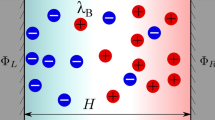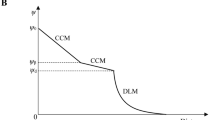Abstract
Within the framework of the Alekseev–Popov–Kolotyrkin model combined with a set of Frumkin isotherms, the adsorption of adamantanol (AdOH) molecules is studied in the presence of a surface-inactive electrolyte and chloride ions at the Hg/H2O interface. The position of points at the beginning and in the end of an equilibrium two-dimensional phase transition is shown to be determined by the equality of (a) surface tension and (b) calculated electrode potentials. With these conditions fulfilled in the phase-transition region, the model of two parallel capacitors with a common diffuse layer (in the AdOH + NaF system) transforms into the classical model of two parallel capacitors with two independent diffuse layers. Taking into account the lateral interaction between adsorbed chloride anions and AdOH molecules makes no difference to the two-dimensional phase transition potential at fixed adsorption parameters. The effect of the diffuse layer on the position of two-dimensional phase transition potentials is analyzed.
Similar content being viewed by others
REFERENCES
Damaskin, B.B. and Baturina, O.A., Elektrokhimiya, 2001, vol. 37, p. 87.
Alekseev, Yu.V., Popov, Yu.A., and Kolotyrkin, Ya.M., Elektrokhimiya, 1976, vol. 12, p. 907.
Damaskin, B.B., J. Electroanal. Chem., 1969, vol. 21, p. 149.
De Levie, R., J. Electrochem. Soc., 1971, vol. 118, p. 185C.
Stenina, E.V. and Damaskin, B.B., J. Electroanal. Chem., 1993, vol. 349, p. 31.
Buess-Hermann, C., J. Electroanal. Chem., 1985, vol. 186, pp. 27, 41.
Buess-Hermann, C., Trends in Interfacial Electrochemistry, Silva, A.F., Ed., Dordrecht: Reidel, 1986, p. 205.
Buess-Hermann, C., Adsorption of Molecules at Metal Electrodes, Lipkowski, J. and Ross, P.N., Eds., New York: VCH, 1992, p. 87.
De Levie, R., Chem. Rev., 1988, vol. 88, p. 599.
Kuryakov, Yu.N., Damaskin, B.B., and Dyatkina, S.L., Elektrokhimiya, 1977, vol. 13, p. 1744.
Frumkin, A.N., Z. Phys., 1926, vol. 35, p. 792.
Damaskin, B.B., Petrii, O.A., and Batrakov, V.V., Adsorbtsiya organicheskikh soedinenii na elektrodakh (Adsorption of Organic Compounds on Electrodes), Moscow: Nauka, 1968, ch. 3.
Baturina, O.A., Damaskin, B.B., Stenina, E.V., and Sviridova, L.N., Elektrokhimiya, 1997, vol. 33, p. 1253.
Nikitas, P., J. Electroanal. Chem., 1998, vol. 446, p. 165.
Armstrong, R.D. and Horrocks, B.R., J. Electroanal. Chem., 1999, vol. 463, p. 9.
Frumkin, A.N., Z. Phys. Chem., 1925, vol. 116, p. 466.
Damaskin, B.B. and Grafov, B.M., Elektrokhimiya, 1991, vol. 27, p. 1166.
Frumkin, A.N., Zh. Fiz. Khim., 1943, vol. 17, p. 310.
Gurevich, Yu.A. and Kharkats, Yu.I., J. Electroanal. Chem., 1978, vol. 86, p. 245.
Praktikum po elektrokhimii (Laboratory Course in Electrochemistry), Damaskin, B.B., Ed., Moscow: Vysshaya Shkola, 1991, p. 74.
Damaskin, B.B. and Dyatkina, S.L., Elektrokhimiya, 1989, vol. 25, p. 1045.
Author information
Authors and Affiliations
Rights and permissions
About this article
Cite this article
Damaskin, B.B., Baturina, O.A. Simulating Coadsorption of Surface Active Anions and Organic Molecules Capable of Forming Two-Dimensional Condensed Layers on the Electrode. Russian Journal of Electrochemistry 37, 121–126 (2001). https://doi.org/10.1023/A:1009019605888
Issue Date:
DOI: https://doi.org/10.1023/A:1009019605888




